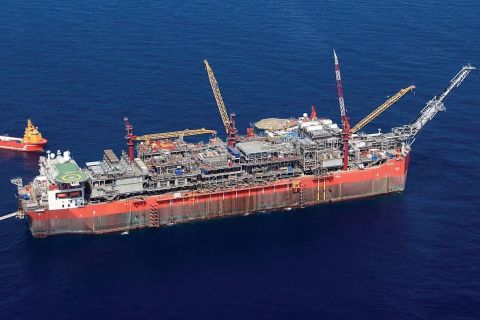Producers seeking oilier production profiles are following South Texas' prolific Eagle Ford formation east into Louisiana and Mississippi, taking a new look at its deeper neighbor, the Tuscaloosa marine shale. It may now be ripe for modern unconventional-play technology—horizontal wellbores and multi-stage fracture stimulation.
The Cretaceous-age, dark-gray source rock sits at between 10,000 and 15,000 feet across some 3.8 million acres in central Louisiana and the westernmost counties of central Mississippi, between the sand and shale mix of the upper and lower Tuscaloosa. A large number of vertical wells have been drilled through it, tapping the lower sands, but only three horizontal tests have been made in the play.
Now, mega-independent Devon Energy Corp. aims to take its own look, with two horizontals planned for the coming months. Its news in early May that it has quietly leased some 250,000 net acres over the shale at about $180 an acre lit a fire under equity analysts' keypads.
Dave Hagar, Devon executive vice president, E&P, says, "This is a frontier play, so I don't want to mischaracterize it as something else…We are leading the industry by taking our position here."
Most encouraging is that the shale is a stratigraphic equivalent of the Eagle Ford and ranges from between 200 and 400 feet in thickness. In fact, it sits below the Louisiana version of the Eagle Ford, which is known there as Eutaw. Total organic content (TOC) is between 3% and 4%. Vertical-well findings suggest good porosity and permeability, and there is evidence of some carbonate content.
Subash Chandra, E&P analyst for Jefferies & Co., notes that the presence of carbonates would improve the outlook for the play. "The preferred rock type for a shale-oil play is a hybrid—that is, a formation with a good mix of non-shale lithofacies, particularly carbonates."
The Middle Bakken and Eagle Ford have this, but "Tuscaloosa appears to be more of a pure shale, with a fairly high clay content. As a result, the shale may be too soft for effective fracture stimulation to keep the fractures from (closing) too quickly."
Encore Acquisition Co. tested Tuscaloosa horizontally in 2008 as oil prices were advancing to $150 a barrel. But it iced the 200,000-acre wildcat program—after three, $7-million-plus wells—when oil prices collapsed.
The first hole met with mechanical failure. The lateral on the second was taken to 3,100 feet, but the casing parted on some 90% of it after completion. Nevertheless, it made 50 barrels a day on pump from the 10% that was open. The third provided better evidence: Weyerhaeuser #1 in St. Helena Parish went the full lateral distance—4,100 feet. It made 323 barrels in its first 24 hours after three frac stages.
Jonny Brumley, Encore president and chief executive, told analysts of the play, "If this really works and gives you a Bakken-type production rate, you'd be very excited; if it doesn't, you'll be disappointed…We know the oil is down there and we know that it is over-pressured."
Denbury Resources Inc. inherited the 200,000 acres when it acquired Encore last year; since then, half of the leasehold has expired and the rest is expiring next year. It's brought in an unidentified partner to complete the fourth hole Encore made into the shale, extend the leases, and drill a fifth well. Denbury also has some 50,000 net held-by-production acres over Tuscaloosa via its legacy CO2-injection oil properties in the region.
Bob Cornelius, Denbury senior vice president, operations, says, "The results are very, very early in this play…We're just going to watch our partner and see if they can unlock the secrets to the Tuscaloosa."
Jack Aydin, E&P analyst for KeyBanc Capital Markets, says Devon's interest in the Tuscaloosa shale means a great deal. "Devon has the technical expertise and deep pockets to potentially crack the code in the play," he says.
Meanwhile, Chandra says that, at Devon's estimated $12-million well cost, Tuscaloosa wells would have to make a first-month average of 1,200 barrels of oil per day to be economic at $85 oil, if they have a production-decline rate like that of Bakken wells. The oil is there, he notes. "But, the challenges are in the drilling and completion phase."
Recommended Reading
Deepwater Roundup 2024: Americas
2024-04-23 - The final part of Hart Energy E&P’s Deepwater Roundup focuses on projects coming online in the Americas from 2023 until the end of the decade.
E&P Highlights: April 22, 2024
2024-04-22 - Here’s a roundup of the latest E&P headlines, including a standardization MoU and new contract awards.
E&P Highlights: March 25, 2024
2024-03-25 - Here’s a roundup of the latest E&P headlines, including a FEED planned for Venus and new contract awards.
E&P Highlights: April 1, 2024
2024-04-01 - Here’s a roundup of the latest E&P headlines, including new contract awards.
Remotely Controlled Well Completion Carried Out at SNEPCo’s Bonga Field
2024-02-27 - Optime Subsea, which supplied the operation’s remotely operated controls system, says its technology reduces equipment from transportation lists and reduces operation time.




